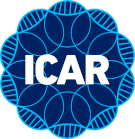Section 04 – DNA Technology
1 Molecular Genetics
1.1 Introduction
Advances in molecular biology, especially genomics, provide a new set of information to be incorporated into the animal industry. On one hand, the use of molecular information may contribute to the enhancement of consumers' trust in the ability to monitor and control the animal production chain. On the other hand, molecular information will greatly contribute to the achievement of genetic improvement for animal traits through the use of genomic breeding values, marker assisted selection, gene introgression, heterosis prediction, pedigree validation/prediction, and genetic defect carrier status. In most cases, advantages of using molecular information via genomic evaluations, comes from improved accuracy of animal breeding values, shortened generation intervals, and increased intensity of selection. Even with these advancements there is still a need for research and development in the search for associations between genetic markers and traits of interest, especially as new traits are included in national evaluation indexes. In addition to that, even with the current incorporation of genomic information into national selection schemes, an understanding of gene action, gene interactions, and differential gene expression to avoid negative collateral effects is needed. Cooperation between animal industries and research is required for a successful and beneficial search for genetic information in commercial livestock populations.
1.2 Genetic Markers
Genetic markers are the fundamental molecular tools for genomics, even as the type of marker used has changed. The first genetic marker associations in livestock were reported using blood typing in the 1960s, the technology then moved to microsatellites (MS) in the 1990s and more recently to the use of Single Nucleotide Polymorphism (SNP). SNP and MS are polymorphic DNA sequences (alleles) at a specific locus of a particular chromosome. While blood typing has been an ICAR approved method of parentage verification currently there are few, if any, commercial labs still offering this testing. For this reason, ICAR no longer recommends blood typing as the basis for carrying out parentage analysis in livestock species where MS or SNP technology is widely available.
1.2.1 Microsatellites
These are segments of DNA containing tandem repeats of simple motifs usually dimers or trimers. These segments are located throughout the genome and normally in non-coding regions. Over time, these regions are subject to the addition or subtraction of tandem repeats, which means that each microsatellite can have multiple unique alleles. Microsatellites are commonly used in many livestock species for parentage validation.
1.2.2 Single Nucleotide Polymorphism (SNP)
SNP are the most common type of genetic variation: each SNP represents a variation in a single nucleotide. There are millions of SNP located throughout the genome of every livestock species. For genomics the most informative SNP traditionally are either located in (a) coding regions where different alleles change the structure or function of the encoded protein, or (b) at non-coding regions that are involved in the regulatory function of the gene. For genomic breeding values, SNP that are located in other regions of the genome are also informative as they could be in linkage disequilibrium with alleles that do cause a phenotype change.
One of the big advantages of SNP is their deployment on SNP arrays with a strong parallel processing capacity whereby thousands or hundreds of thousands of SNP can be screened together in a cost-effective and efficient manner across a large number of animals. Currently, the largest livestock genotyping labs can process hundreds of thousands of animals yearly on such arrays. The availability of these large SNP panels is therefore bolstering the search for mutations underlying genetic variation for simple and complex traits. It is also revolutionizing the speed at which trait associated genes or gene regions are being discovered as well as the adoption rate of genomic selection strategies. SNP genotypes have become the international standard for the basis of parentage analysis and ICAR recommends this approach over the use of microsatellites wherever possible due to the improved accuracy and the ease of comparing results between genotyping laboratories.
